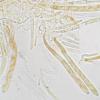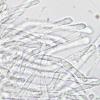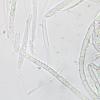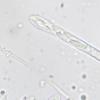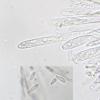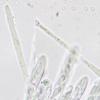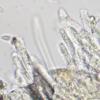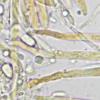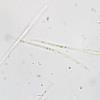
13-01-2019 13:32
 Andgelo Mombert
Andgelo Mombert
Bonjour à tous, Sur branchette d'Abies alba, le

12-01-2019 14:05
 Viktorie Halasu
Viktorie Halasu
Hello forum,is this correctly identified as Ceutho

12-01-2019 13:29
 Marc Detollenaere
Marc Detollenaere
Hello forum, On rabbit dung that I collected 2 we

12-01-2019 15:40
 Viktorie Halasu
Viktorie Halasu
Hello forum,there is another anamorph from Hedera

10-01-2019 16:13
Thorben HülsewigHi there,Bernd Fellmann found an interesting Nectr

08-01-2019 19:43
Manak RomanHi all, in December, I found small Hymenoscyphus

09-01-2019 21:28
This is new for me. Found on Fagus, in Norway.The
Lachnellula aff subtilissima
Andgelo Mombert,
13-01-2019 13:32

Bonjour à tous,
Sur branchette d'Abies alba, le 12/01/2019, dans le Jura.
Vous remarquerez que sur la photo on voit deux populations de Lachnellula macroscopiquement différentes.
L'une correspond exactement à Lachnellula subtilissima que j'ai l'habitude de récolter.
Par contre l'autre, que je décris ci-dessous, diffère microscopiquement par les asques sans crochet (ni protubérances).
Description :
-Ascospores : 7,5-8 x 2,5 µm, fusoïdes, hyalines, lisses. Mesures à prendre avec des pincettes, j'ai vu peu de spores sorties des asques.
-Asques : 48-68 x 4-4,5 µm (mortes : 45-55 x 2,5-3,5 µm), cylindriques, sans crochet ni protubérances, à sommet hémiamyloïde (appareil apical rouge-brun) contenant huit spores unisériées à bisériées.
-Paraphyses : cylindriques, grêles, dressées, avec un pigment orangé composé de granules, larges de 1,4-1,8 µm.
-Poils : dépassant les 200 µm de longueur, cylindriques, hyalins, septés, entièrement granuleux, à sommet un peu élargi, larges de 2,5-3,5 µm.
-Asques : 48-68 x 4-4,5 µm (mortes : 45-55 x 2,5-3,5 µm), cylindriques, sans crochet ni protubérances, à sommet hémiamyloïde (appareil apical rouge-brun) contenant huit spores unisériées à bisériées.
-Paraphyses : cylindriques, grêles, dressées, avec un pigment orangé composé de granules, larges de 1,4-1,8 µm.
-Poils : dépassant les 200 µm de longueur, cylindriques, hyalins, septés, entièrement granuleux, à sommet un peu élargi, larges de 2,5-3,5 µm.
On pourrait légitimement croire qu'il y a deux espèces différentes... À moins que ça rentre dans la variabilité de subtilissima ?
Merci pour votre aide
Andgelo
Hans-Otto Baral,
13-01-2019 15:28

Re : Lachnellula aff subtilissima
Hi Andgelo
indeed they look as two different. This would be a great opportunity to clarify by DNA whether two species are involved. Did you document also the smaller one? How is apothecial size?
I believed this species to be variable, and sometimes even without iodine reaction, but in the meantime I consider existence of different species, because I think I did not see such variation within a population so far.
If you dry this specimen, try to separate the populations, you could harvest all smaller pale yellow ones into a small envelope to be sure that later studies will not mix them.
Zotto
indeed they look as two different. This would be a great opportunity to clarify by DNA whether two species are involved. Did you document also the smaller one? How is apothecial size?
I believed this species to be variable, and sometimes even without iodine reaction, but in the meantime I consider existence of different species, because I think I did not see such variation within a population so far.
If you dry this specimen, try to separate the populations, you could harvest all smaller pale yellow ones into a small envelope to be sure that later studies will not mix them.
Zotto
Andgelo Mombert,
13-01-2019 15:41

Re : Lachnellula aff subtilissima
Merci beaucoup Zotto pour ta réponse qui confirme mon pressentiment.
Lachnellula croziers- atteint 5 mm de diamètre ; Lachnellula subtilissima croziers+ atteint quand-à-elle 2 mm de diamètre.
Je suis en train de travailler la seconde. Dès que j'ai fini je poste la description sur le forum.
Andgelo Mombert,
13-01-2019 18:36

Re : Lachnellula aff subtilissima
Description de la petite Lachnellula qui pour moi correspond à Lachnellula subtilissima type.
-Spores : 7-8 x 2-2,5 µm, naviculaires, hyalines, avec parfois des granulations, lisses.
-Asques : 60-70 x 4,5-5,5 µm (morts : 50-55 x 4,5-5,5 µm), cylindriques, avec crochet, à -sommet hémiamyloïde (rouge-brun), contenant huit spores unisériées ou bisériées.
-Paraphyses : cylindriques, dressées, septées, larges de 2,3-2,8 µm.
-Poils : cylindriques, septés, entièrement granuleux, un peu renflés au sommet, larges de 3-4,2 µm.
Comme différence avec l'autre Lachnellula - outre les crochets - je note surtout des paraphyses plus larges.
Je sèche tout.
Andgelo
Hans-Otto Baral,
13-01-2019 20:34

Re : Lachnellula aff subtilissima
O.k., good! You say wider paraphyses. In aff. subtilissima you did not figure them, or? Maybe they were dead and therefore narrower?
Ascus and spore size sound quite similar, also spore shape.
The croziers I only see from the broken ascus base, but clearly it is different from the aff. subtil.
I have not enough documents of this complex to compare, and my older ones are even without info about croziers.
Ascus and spore size sound quite similar, also spore shape.
The croziers I only see from the broken ascus base, but clearly it is different from the aff. subtil.
I have not enough documents of this complex to compare, and my older ones are even without info about croziers.
Andgelo Mombert,
13-01-2019 20:40
Hans-Otto Baral,
13-01-2019 21:22

Re : Lachnellula aff subtilissima
ah, they are dead, you can see this at the septa which are very slightly constricted in the living p. of typical L. subt, but very slightly protruding in the dead p. of aff. subt. - This means due to the turgor loss the lateral wall collapses a bit, which is best seen near to the rigid septa.
Andgelo Mombert,
14-01-2019 20:00

Re : Lachnellula aff subtilissima
D'accord, merci Zotto. Affaire à suivre donc...
Déroutants ces ascomycètes, on fait des découvertes même pour sur espèces que l'on croit connaitre...
Andgelo



